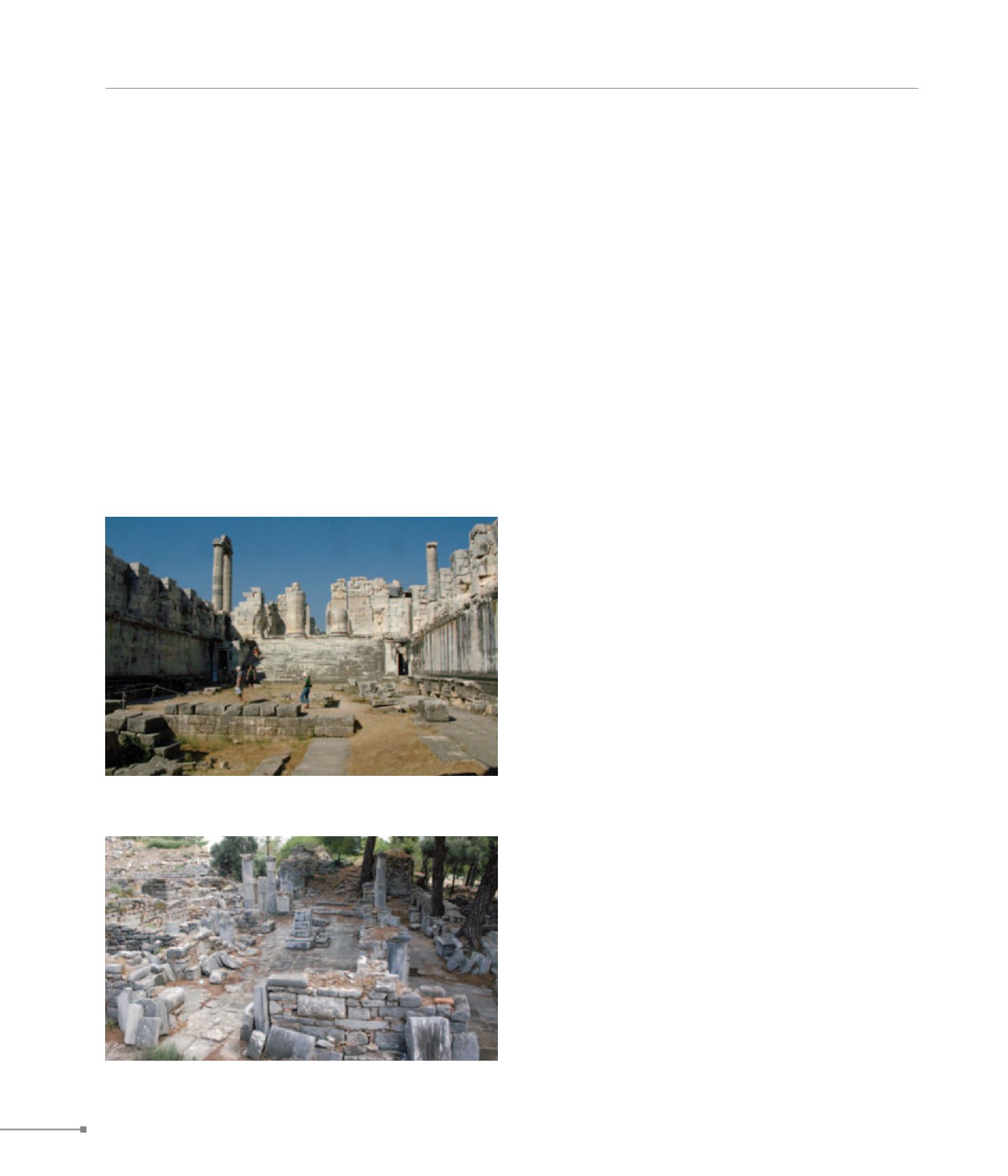
Didim. Didyma, Justinianopolis.
Güllübahçe. Priene.
COASTLINE OF ASIA MINOR AND EASTERN THRACE
300
552. Priene, basilica (Πριήνη, βασιλική)
550. Didyma, Apollo sanctuary (Δίδυμα, ιερό του Απόλλωνα)
551.
Balat. Miletus.
550.
Didim
.
Didyma, Justinianopolis.
After a Goth raid in 262, the famous sanctuary of Apollo had
its six middle columns embedded in a wall and joined with the
protruding walls of the temple’s cella to create a fortress. The
rebuilding of the sanctuary was interrupted in 391 during the
time of Theodosius I. In its large courtyard a three-aisled ba-
silica was constructed circa 500 (?), which was later destroyed
during archaeological excavations at the ancient temple. The
E section of the basilica was above the monumental staircase,
while the baptistery, a triconch structure surviving in good
condition, was W of the basilica. Many examples of architec-
tural sculptures survive. The fortress was reinforced by Byzan-
tine Emperor Justinian I (r. 527-565), and possibly during the
Arab raids that started from the mid-7th c. In the late 10th c.
the church and the fortress were reshaped, following a fire, ac-
cording to an inscription of 988. The site, named “Ieron”, was
used as a bishop’s see until the 13th c. Remnants of archi-
tectural sculptures indicate that a cross-in-square church ex-
isted at the site in the Mid-Byzantine period. Both the ancient
temple and the basilica were destroyed by earthquake in the
mid-13th c. An earthquake in 1493 caused many columns of
the ancient sanctuary to collapse. The following works all took
place in the Early Byzantine period: reshaping of the thermae
(early 5th c.), the projects on the main street (5th-6th c.), and
the destruction of the sanctuary of Artemis and the basilica
built at the edge of the city. After 533 the city was renamed
Justinianopolis. Close to Didyma lie, among other places of
worship, Panagia of Dekapentavgoustos, and a three-aisled
basilica. Further churches have been detected from building
remains and from architectural sculptures.
The lower sections of the walls of the “Great Ekklesia”, con-
structed circa 530-40, survive in good condition. The church’s
plan included parts of earlier buildings. As a result the pro-
pylon had been removed from the axis of the church. To the
N lies the baptistery and to the SE a circular structure with
interior conches, possibly a martyrium. The church of Arch-
angel Michael and the neighbouring bishop’s palace to its N
were built circa 600, according to the founder’s inscription, at
the site of the sanctuary of Dionysus, where in the early 5th c.
a church had been established. The “Round Ekklesia” S of
the city has a complicated building history and it cannot be
safely determined if it had been built from the foundations. It
seems that a circular building was established above an older
residence and was converted into a church in the 5th c. It was
supplied with a small apse and eight columns were added
to support the dome. Architectural sculptures attest the exist-
ence of other churches that have not been discovered. The
building that was established by Emperor Justinian and his
wife Theodora in 538 has not been detected, according to an
extensive inscription embedded in the gate of the city walls.
During the Arab raids, circa 800, the theatre was converted
into a small fortress. The city was fortified again in the mid-
12th c. after it suffered destruction by earthquakes, and thus
it was restricted to the hill NE of the theatre. The fortress was
repaired in the early 13th c., in the era of the ruling Laskaris
family, emperors of Nicaea.
Ionia
552.
G
ü
ll
ü
bah
ç
e. Priene.
There are impressive remains of a three-aisled basilica (first
half of the 5th c.), located S of the theatre among other struc-
tures from which building material has been taken. Circa 500
the church underwent a transformation and, in a third phase,


